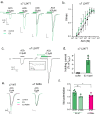An original potentiating mechanism revealed by the cryo-EM structures of the human α7 nicotinic receptor in complex with nanobodies
- PMID: 37749098
- PMCID: PMC10520083
- DOI: 10.1038/s41467-023-41734-4
An original potentiating mechanism revealed by the cryo-EM structures of the human α7 nicotinic receptor in complex with nanobodies
Abstract
The human α7 nicotinic receptor is a pentameric channel mediating cellular and neuronal communication. It has attracted considerable interest in designing ligands for the treatment of neurological and psychiatric disorders. To develop a novel class of α7 ligands, we recently generated two nanobodies named E3 and C4, acting as positive allosteric modulator and silent allosteric ligand, respectively. Here, we solved the cryo-electron microscopy structures of the nanobody-receptor complexes. E3 and C4 bind to a common epitope involving two subunits at the apex of the receptor. They form by themselves a symmetric pentameric assembly that extends the extracellular domain. Unlike C4, the binding of E3 drives an agonist-bound conformation of the extracellular domain in the absence of an orthosteric agonist, and mutational analysis shows a key contribution of an N-linked sugar moiety in mediating E3 potentiation. The nanobody E3, by remotely controlling the global allosteric conformation of the receptor, implements an original mechanism of regulation that opens new avenues for drug design.
© 2023. Springer Nature Limited.
Conflict of interest statement
G.A., P.J.C., P.L., M.S.P. and N.B. are inventors of patent application US 63/383,099 that covers the nanobodies and therapeutic uses thereof. The remaining authors declare no competing interests.
Figures






Similar articles
-
Structural mechanisms of α7 nicotinic receptor allosteric modulation and activation.Cell. 2024 Feb 29;187(5):1160-1176.e21. doi: 10.1016/j.cell.2024.01.032. Epub 2024 Feb 20. Cell. 2024. PMID: 38382524 Free PMC article.
-
Generation of nanobodies acting as silent and positive allosteric modulators of the α7 nicotinic acetylcholine receptor.Cell Mol Life Sci. 2023 May 25;80(6):164. doi: 10.1007/s00018-023-04779-8. Cell Mol Life Sci. 2023. PMID: 37231269 Free PMC article.
-
An allosteric binding site of the α7 nicotinic acetylcholine receptor revealed in a humanized acetylcholine-binding protein.J Biol Chem. 2018 Feb 16;293(7):2534-2545. doi: 10.1074/jbc.M117.815316. Epub 2017 Dec 13. J Biol Chem. 2018. PMID: 29237730 Free PMC article.
-
Recent Advances in the Discovery of Nicotinic Acetylcholine Receptor Allosteric Modulators.Molecules. 2023 Jan 28;28(3):1270. doi: 10.3390/molecules28031270. Molecules. 2023. PMID: 36770942 Free PMC article. Review.
-
Silent agonists for α7 nicotinic acetylcholine receptors.Pharmacol Res. 2023 Apr;190:106736. doi: 10.1016/j.phrs.2023.106736. Epub 2023 Mar 20. Pharmacol Res. 2023. PMID: 36940890 Review.
Cited by
-
A General Method to Screen Nanobodies for Cytochrome P450 Enzymes from a Yeast Surface Display Library.Biomedicines. 2024 Aug 15;12(8):1863. doi: 10.3390/biomedicines12081863. Biomedicines. 2024. PMID: 39200327 Free PMC article.
-
Corrections to "VHH Nanobody Versatility against Pentameric Ligand-Gated Ion Channels".J Med Chem. 2025 Jun 12;68(11):12286. doi: 10.1021/acs.jmedchem.4c02703. Epub 2025 Jun 2. J Med Chem. 2025. PMID: 40457707 Free PMC article. No abstract available.
-
Structural basis for allosteric agonism of human α7 nicotinic acetylcholine receptors.Cell Discov. 2025 Apr 8;11(1):35. doi: 10.1038/s41421-025-00788-y. Cell Discov. 2025. PMID: 40195322 Free PMC article.
-
Structural mechanisms of α7 nicotinic receptor allosteric modulation and activation.Cell. 2024 Feb 29;187(5):1160-1176.e21. doi: 10.1016/j.cell.2024.01.032. Epub 2024 Feb 20. Cell. 2024. PMID: 38382524 Free PMC article.
References
Publication types
MeSH terms
Substances
LinkOut - more resources
Full Text Sources
Molecular Biology Databases
Miscellaneous

